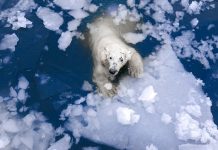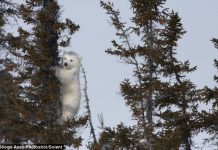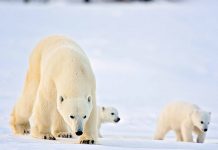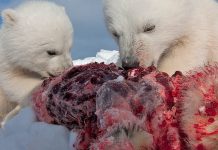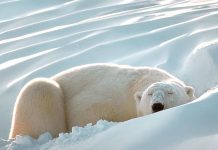The early winter in the Arctic is thought to be the ideal denning season for polar bears. Pregnant females excavate dens in order to raise their cubs and emerge only when cubs attain 3 months of age. Polar bear dens are likely to reflect on the polar bear population in a specified location. The greater is the density of dens the larger is the bear’s population.
Dens occur widely in Svalbard Archipelago, Novaya Zemlya, Franz Joseph Land, and Wrangel Island in Russia. In Russia dens are also found in the rugged mountains as well as in fjordlands. In Alaska however researchers did not seem to find any significant denning sites. The probable reason is that Alaska gets only little snow.
Polar Bear Den Facts
The denning site must be abundant in snow and the thickness of the ice should be enough to cover snow caves or tunnels. Furthermore, dens also depend on the weather and topographic conditions.
Description of a Polar Bear Maternity Den
Polar bear females make dens in the steep slope or snow. The pregnant females make dens that measure 1 – 3 meters in depth. Polar bear den is not so simple. It has one narrow entrance which is followed by a long tunnel. The tunnel may run several meters.
The average length of the den is about 15 feet (5 meters) with a chamber measuring up to 20 square feet.
The width measures around 1.38 meters whereas the height is about 0.8 meter.
The average size of the den is about 0.5 by 3.0 by 1.5 m (8 x 10 x 5 feet) lacking ventilation hole.
The bear’s den consists of oval chambers with three cubic meters in volume. Just to be on the safer side females build dens 5 – 8 kilometers off the coast. However in the Hudson Bay dens may be found as far ashore as 29 – 118 km inland.
The maternity dens are built on the slanting surface measuring 20 – 40 degrees. The density of snow is around 1 – 3 meters.
Read More: Do Polar Bears Hibernate?
Condition of the Polar Bear Den
In the James Bay or Hudson Bay females often dig dens in earth. It happens mostly in summer because the bear must cool herself. In the East Greenland or Beaufort Sea polar bears make dens within the thick ice sheet consisting of multiple layers. The overall protection of snow is there even when they make dens in earth.
While the outside temperature drops to -50 °C (-58 °F) the temperature inside the den remains at 0 °C (32 °F). This shows the real skill of a female polar bear. The cubs remain not only safe from predators but also become weather protected.
Read More: Polar Bear Cubs
The Ontario bears usually make dens where there is greatest density of snow. In Manitoba polar bears build dens along the streams the den is hid in the trees. In the Canadian High Arctic bears make slanted dens that face towards south because the northward winds should slip over it without entering inside.
Polar bears inhabiting the Wrangel Island are not so lucky to have snow all year-round; they should wait for the months when the snow accumulation is the greatest. As a result the females do not dig dens on varied locations
Dens are not always made with multiple chambers. They also make single-chamber den with simple construction. Similarly the tunnel might sometimes run for few centimeters instead of meters. The Ontario bears are known to make dens such as this.
Location of the Polar Bear Den
Polar bears may or may not use the same denning site. The same bear rarely builds den on the older site. They will keep 30 – 40 meters distance between the older site and newer site. Polar bears may either scatter their dens (larger denning site) or simply accumulate them in a small area.
In the Wrangel Island and Svalbard Island dens are concentrated at a particular place distancing only 30 meters apart. But in Ontario the dens are quite scattered and are also 74 miles off the coast.
In northern Alaska polar bears are thought to make dens on river banks, lake shore and coastal banks. Some dens are complex whereas others are fairly simple. The thickness of the snow that lies above the den is one meter. According to research about 80% of the Alaskan dens occur only 10 kilometers off the coast.
Read More: When Do Polar Bears Leave their Mother?


Purpose of Maternity Dens
The primary purpose of maternity den is to raise cubs while protecting them from potential land-based predators.
Apart from nurturing, females also conserve energy by relaxing during the ice-free months.
As the winter approaches the pregnant female begins excavating snow dens. She will stay inside the den for approximately 3 months—to give birth in midwinter. Dens on the pack ice are relatively safer. The mother rarely leaves the cubs alone inside the den. That is why when cubs are able to walk she leaves (the den) along with them.
Polar Bear Dens on the Sea Ice
Researchers found 53% of the polar bear dens on the drifting ice. The rapid climate change forces the ice to move faster than before—rendering dens to be redundant. Nonetheless, the overall success rate is the same as compared to those constructed on land.
When the ice pack breaks to refreeze again the female carries her newborn cubs in a desperate attempt to transfer them to a new den.
Polar bears need to stay inside the den in the initial to 5 months so that the cubs’ production remains successful. In summer however they can afford to build dens on land.
